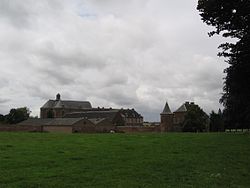Argenton Abbey
| Argenton Cistercian Abbey | |
|---|---|

|
|
| location | Belgium Province of Namur |
| Coordinates: | 50 ° 33 '4 " N , 4 ° 44' 23" E |
| founding year | 1229 |
| Year of dissolution / annulment |
1796 |
| Mother monastery | Villers-la-Ville monastery |
The Argenton Abbey in Lonzée, a district of Gembloux ( Belgium ) was a nunnery of the Cistercian order . It was founded in 1229 and disbanded during the Revolution in 1796 . The preserved buildings from the 18th century, including the abbess's palace and the church, now form the Argenton estate ( Château-ferme d'Argenton ). In 1992 the plant was listed as a historical monument together with the Harton watermill.
history
In 1229, a community of Augustinian women from Grandval (Balâtre, today Jemeppe-sur-Sambre , Belgium) settled on land given to them by Guillaume de Harenton on the banks of the Arton. Donations from other nobles such as Baldwin von Courtenay , Count of Namur , enlarged the property. Shortly after joining the Cistercian order, the community was subordinated to the Villers-la-Ville monastery as the mother house.
At the beginning of the 15th century, the abbess Marie de Gembloux led around 80 nuns. After her death (1418), in the course of reforms in the order to increase monastic discipline, two nuns from the Abbey of Notre-Dame de Soleilmont , which had an excellent reputation in this regard, were sent to Argenton, who took over the management of the monastery one after the other: Marie de Gentinnes († 1438) and Nicaise de Harby.
At the end of the 16th century, Argenton Abbey also suffered from the consequences of the Eighty Years' War (1568–1648). During the Battle of Gembloux in 1578, it served as Juan de Austrias headquarters . From here he informed the King of Spain of his victory over the army of the Seventeen Provinces .
Placide Deseslys, monk from Villers and confessor for Argenton, left a history of the abbey including a list of the nuns since the abbey was founded ( Registre contenant les noms des religieuses d'Argenton depuis sa fondation, avec un précis de l'histoire de cette maison ... ), which dates from 1764 and is now in the State Archives in Namur , and in which he describes the turbulence at the end of the 16th century, including the nuns' frequent flight to Namur and their return to a looted and damaged monastery . In addition to the external, there was an internal crisis in 1618 when the abbess Marguerite de Royers was deposed from the order, the reasons for which were not known.
The 18th century was a time of rebirth for Argenton. The abbey was rebuilt between 1722 and 1747 by the architect Jean Maljean from Namur, the buildings that are preserved today (palace and church) date from this period. In 1755, Martin Staignier, the abbot of Villers, portrayed Argenton in such an exemplary way that his own monks revolted against him and even reported him in Cîteaux for stinginess. However, the subsequent official investigation acquitted him of the allegation.
Humbeline Disbeek of Ittre , elected in 1766 at the age of 40, was the last abbess of Argenton. In 1796 the monastery was dissolved by the revolutionary government, despite its exemplary reputation, and the nuns dispersed in all directions. In 1797 the abbey was sold as national property to Jean-Baptiste Paulée; in the purchase contract it was stated that the domain cultivated by the abbey was 850 hectares (130 bonniers de terre ).
The monastery, which has since been leased as a farm, changed hands several times in the 19th and 20th centuries. As the farm continues to exist as a private property, a visit to the abbey is not permitted.
literature
- Joseph-Marie Canivez: L'ordre de Cîteaux en Belgique, des origines au XXe siècle , Forges-lez-Chimay, 1926.